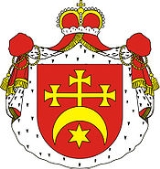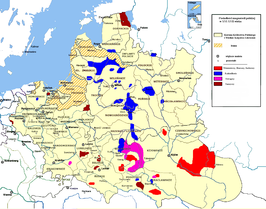
Wisniowiecki
Encyclopedia
Wiśniowiecki is the name of a family notable in the history of Polish-Lithuanian Commonwealth
. They were powerful magnate
s in Ruthenia
(Ukraine) of Rurikid or Gediminids
descent. The family traditions traces their descend to Gediminids, but modern historians believe there is more evidence for the Rurikid version. According to the Geminids relation theory, the ancestor of the family was Duke Kaributas (Ruthenian: Dymitr Korybut), a son of the Grand Duke of Lithuania, Algirdas
. His son Fedor of Nesvizh
started the family.
The name of the family can be traced to their estates in Wiśniowiec (now Vyshnivets
, Ukraine).
From their days as Ruthenian nobility they held the Kniaz (prince) title. By late 16th century, the family converted from Orthodox
to Catholicism
and became Polonized. They gained much importance in the Polish-Lithuanian Commonwealth
, with vast possessions in the 16th to 18th centuries on the territories of today's Ukraine
, particularly the town of Vyshnivets
. Their estates were so vast, and their position so powerful, that they were known as the most powerful of magnate
s - the "little kings" ("królewięta").
The family's Golden Age was the 17th century, when its members accumulated much wealth and influence, held numerous important posts within the Commonwealth. Likely the most notable members of this family were Michał I Korybut Wiśniowiecki, king of Poland and Grand Duke of Lithuania from 1669 to 1673, and his father Jeremi Wiśniowiecki
.

Polish-Lithuanian Commonwealth
The Polish–Lithuanian Commonwealth was a dualistic state of Poland and Lithuania ruled by a common monarch. It was the largest and one of the most populous countries of 16th- and 17th‑century Europe with some and a multi-ethnic population of 11 million at its peak in the early 17th century...
. They were powerful magnate
Magnate
Magnate, from the Late Latin magnas, a great man, itself from Latin magnus 'great', designates a noble or other man in a high social position, by birth, wealth or other qualities...
s in Ruthenia
Ruthenia
Ruthenia is the Latin word used onwards from the 13th century, describing lands of the Ancient Rus in European manuscripts. Its geographic and culturo-ethnic name at that time was applied to the parts of Eastern Europe. Essentially, the word is a false Latin rendering of the ancient place name Rus...
(Ukraine) of Rurikid or Gediminids
Gediminids
The Gediminids were a dynasty of monarchs of Grand Duchy of Lithuania that reigned from the 14th to the 16th century. One branch of this dynasty, known as the Jagiellons, reigned also in Kingdom of Poland, Kingdom of Hungary and Kingdom of Bohemia...
descent. The family traditions traces their descend to Gediminids, but modern historians believe there is more evidence for the Rurikid version. According to the Geminids relation theory, the ancestor of the family was Duke Kaributas (Ruthenian: Dymitr Korybut), a son of the Grand Duke of Lithuania, Algirdas
Algirdas
Algirdas was a monarch of medieval Lithuania. Algirdas ruled the Grand Duchy of Lithuania from 1345 to 1377, which chiefly meant monarch of Lithuanians and Ruthenians...
. His son Fedor of Nesvizh
Nesvizh
Nesvizh is a city in Belarus. It is the administrative center of the Nesvizh District of Minsk Province and location of the Nesvizh Castle World Heritage Site. Its 2009 population is 14,300 .-History:...
started the family.
The name of the family can be traced to their estates in Wiśniowiec (now Vyshnivets
Vyshnivets
Vyshnivets is a small town in the Zbarazkyi Raion of the Ternopil Oblast of western Ukraine. The town is located on the Horyn River, a right tributary of the Prypiat. The population of the town is 3,469...
, Ukraine).
From their days as Ruthenian nobility they held the Kniaz (prince) title. By late 16th century, the family converted from Orthodox
Eastern Orthodox Church
The Orthodox Church, officially called the Orthodox Catholic Church and commonly referred to as the Eastern Orthodox Church, is the second largest Christian denomination in the world, with an estimated 300 million adherents mainly in the countries of Belarus, Bulgaria, Cyprus, Georgia, Greece,...
to Catholicism
Catholicism
Catholicism is a broad term for the body of the Catholic faith, its theologies and doctrines, its liturgical, ethical, spiritual, and behavioral characteristics, as well as a religious people as a whole....
and became Polonized. They gained much importance in the Polish-Lithuanian Commonwealth
Polish-Lithuanian Commonwealth
The Polish–Lithuanian Commonwealth was a dualistic state of Poland and Lithuania ruled by a common monarch. It was the largest and one of the most populous countries of 16th- and 17th‑century Europe with some and a multi-ethnic population of 11 million at its peak in the early 17th century...
, with vast possessions in the 16th to 18th centuries on the territories of today's Ukraine
Ukraine
Ukraine is a country in Eastern Europe. It has an area of 603,628 km², making it the second largest contiguous country on the European continent, after Russia...
, particularly the town of Vyshnivets
Vyshnivets
Vyshnivets is a small town in the Zbarazkyi Raion of the Ternopil Oblast of western Ukraine. The town is located on the Horyn River, a right tributary of the Prypiat. The population of the town is 3,469...
. Their estates were so vast, and their position so powerful, that they were known as the most powerful of magnate
Magnate
Magnate, from the Late Latin magnas, a great man, itself from Latin magnus 'great', designates a noble or other man in a high social position, by birth, wealth or other qualities...
s - the "little kings" ("królewięta").
The family's Golden Age was the 17th century, when its members accumulated much wealth and influence, held numerous important posts within the Commonwealth. Likely the most notable members of this family were Michał I Korybut Wiśniowiecki, king of Poland and Grand Duke of Lithuania from 1669 to 1673, and his father Jeremi Wiśniowiecki
Jeremi Wisniowiecki
Jeremi Michał Korybut Wiśniowiecki was a notable member of the aristocracy of the Polish-Lithuanian Commonwealth, Prince at Wiśniowiec, Łubnie and Chorol and a father of future Polish king Michał I...
.
Notable family members

- Dmytro VyshnevetskyDmytro VyshnevetskyDmytro Ivanovych Vyshnevetsky was a Hetman of the Ukrainian Cossacks. He was also known as Baida in the Ukrainian folk songs.-Biography:...
(first AtamanAtamanAtaman was a commander title of the Ukrainian People's Army, Cossack, and haidamak leaders, who were in essence the Cossacks...
of the Ukrainian CossackCossackCossacks are a group of predominantly East Slavic people who originally were members of democratic, semi-military communities in what is today Ukraine and Southern Russia inhabiting sparsely populated areas and islands in the lower Dnieper and Don basins and who played an important role in the...
s, Hetman of the Registered Cossacks). - Janusz WiśniowieckiJanusz WisniowieckiJanusz Wiśniowiecki , koniuszy wielki koronny from 1633, starost of Krzemieniec.In 1631 after the death of Jerzy Zbaraski inherited Puławy.Married to Katarzyna Eugenia Tyszkiewicz...
(Master of the Stables of the Crown.) - Dymitr Jerzy WiśniowieckiDymitr Jerzy WisniowieckiPrince Dymitr Jerzy Wiśniowiecki was a Polish magnate and szlachcic.Wiśniowiecki was Great Guard of the Crown from 1658, Field Hetman of the Crown from 1668, Great Crown Hetman from 1676, voivode of Belz 1660–1678 and Kraków 1678–1681, and castellan of Kraków from 1681...
(Great Guard and HetmanHetmanHetman was the title of the second-highest military commander in 15th- to 18th-century Poland and the Grand Duchy of Lithuania, which together, from 1569 to 1795, comprised the Polish-Lithuanian Commonwealth, or Rzeczpospolita....
of the Crown, voivode of Belz and Kraków) - Janusz Antoni Wisniowiecki
- Jeremi WiśniowieckiJeremi WisniowieckiJeremi Michał Korybut Wiśniowiecki was a notable member of the aristocracy of the Polish-Lithuanian Commonwealth, Prince at Wiśniowiec, Łubnie and Chorol and a father of future Polish king Michał I...
(Prince at Wiśniowiec, Łubny and Chorol, Palatine of Ruthenia.) - Michał Korybut Wiśniowiecki (King of the Polish-Lithuanian Commonwealth 1669-1673.)
- Michał Serwacy Wiśniowiecki (Hetman, CastellanCastellanA castellan was the governor or captain of a castle. The word stems from the Latin Castellanus, derived from castellum "castle". Also known as a constable.-Duties:...
and Voivode of Vilnius, Great Chancellor of Lithuania)
See also
- WiśniowiecVyshnivetsVyshnivets is a small town in the Zbarazkyi Raion of the Ternopil Oblast of western Ukraine. The town is located on the Horyn River, a right tributary of the Prypiat. The population of the town is 3,469...
- Lithuanian nobility
- Kings of Poland
- szlachtaSzlachtaThe szlachta was a legally privileged noble class with origins in the Kingdom of Poland. It gained considerable institutional privileges during the 1333-1370 reign of Casimir the Great. In 1413, following a series of tentative personal unions between the Grand Duchy of Lithuania and the Kingdom of...

